(via TheNewswire)
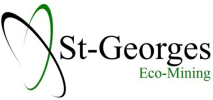


Conclusions from this year’s exploration work - Based on past and recent work programs, the Company believes that there is potential for a larger mineralized source at depth for the narrow near-surface mineralization identified to date. The basis for this theory is suggested by mineralization hosted in several different rock types along a N60°E trend related to a strong conductor as defined by an airborne EM geophysical survey and bodies of intrusive rocks similar to large mineralized systems located around the world. The company intends to pursue additional work including additional prospecting and drilling in the future to confirm this theory.
A total of 4,198 meters over 11 holes was drilled on the JulieProject, the bulk of which consisted of holes positioned to conduct a borehole geophysical review of the project and identify targets for the second phase of exploration drilling that was initiated in October. Additional material was collected through surface grab and channel sampling in the initial surface exploration phase. Results from this effort are summarized below.
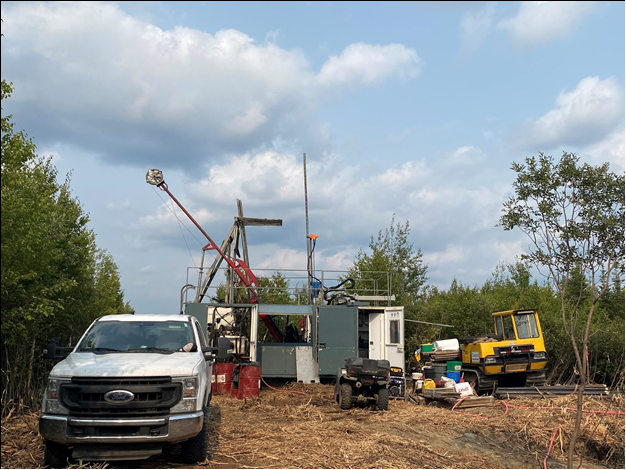
Click Image To View Full Size
2021 EXPLORATION SUMMARY ON THE JULIE PROJECT
2021 EXPLORATION SUMMARY ON THE JULIE PROJECT
Prospection work program (Phase 1 May-
From May to
Only small sections of the
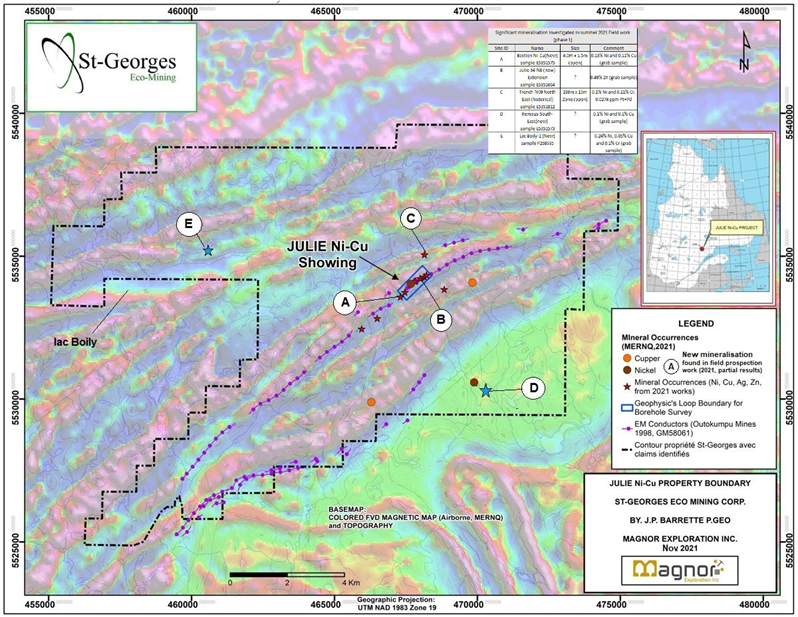
Click Image To View Full Size
Fig. 1:
1 Magnetic susceptibility and relative EM conductivity detector From GDD geophysics instruments
2The
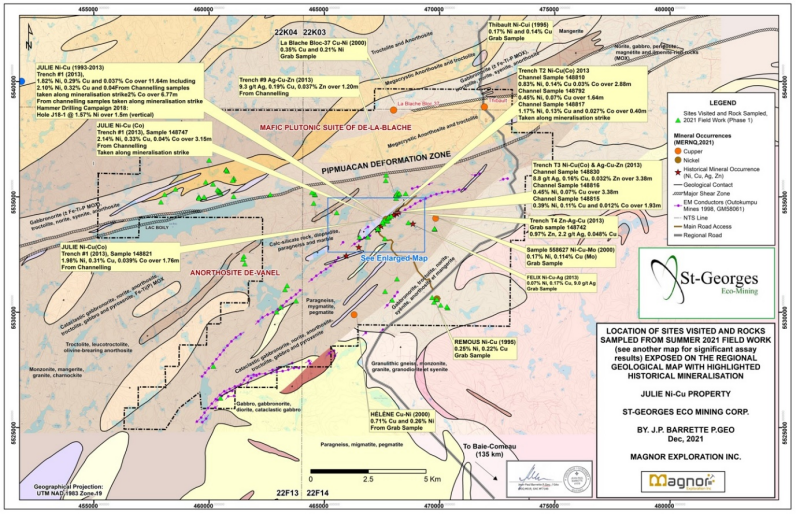
Click Image To View Full Size
Fig. 2:
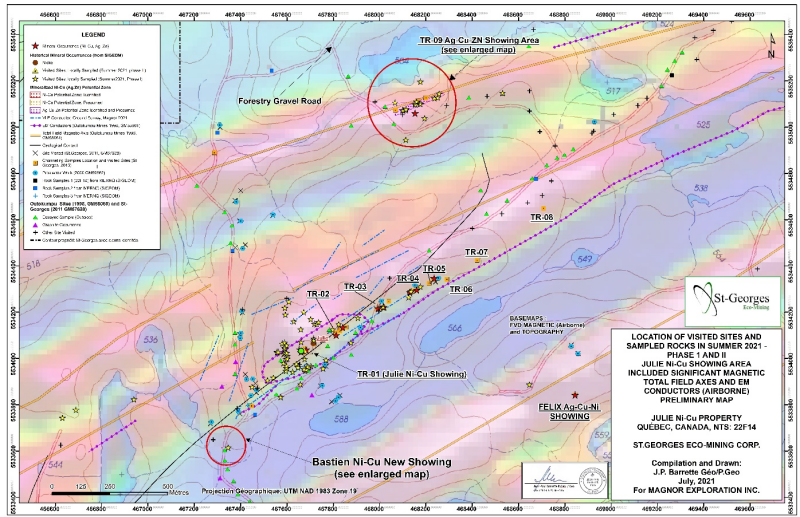
Click Image To View Full Size
Fig. 3:
Notable results from the surface work campaign are shown in Figure 1, and readers will find detailed descriptions hereinafter.
Site (A): The new
Site (B): About 300 meters northeast of the Julie (T1) showing, a grab sample was taken outside the historical trench within what appears to be graphitic and sulfide-rich metasediments which carry 5 to 10% sulfides, mainly pyrite. The sample grade 0.50% zinc. No further work has been done on this target.
Site (C):Close to the historical Trench #9, a Zn-Ag-Cu mineral occurrence was located about 1,275 meters from Julie(T1)showing. A grab sample from the northeast extension of the historical trench returned grades of 0.1% nickel and 0.21% chromium. The mineralization appears to be hosted in biotite-garnet-magnetite bearing paragneiss.
Site (D):Located approximately 600 meters southeast of the historical Remous showing. A grab sample from the anorthosite with 1 to 3% sulfidesat surfacereturned grades of 0.1% nickel and 0.1% copper.
Site (E):Several channel cuts and rock samples have been collected in the northwest section of the newly acquired claims north of the Lac Boily area. This section of claims has been underexplored by the Company historically and the area was not renewed for many years until recently. A team of geologists from the Company scouted the area earlier this year.The sector contains a rusty stained zone covering approximately 8 km x 3 km (A. Berclaz 2021). The zone consists of extensive rusty patched feldspar-quartz porphyritic felsic intrusion, possibly associated with leuco to melanocratic gabbro (possibly gabbronorite) intruding pillowed metabasaltic host rock formation. The dike or stock identified is strongly cataclastic and brecciated with numerous small to large polylithic enclaves composed of fine to coarse-grained felsic rock with inclusions of rusty stained mafic and ultramafic rocks.
A sample taken in siliceous hornblende-biotite bearing metabasalt containing 1-2% sulfides in relative contact with the felsic dike returned grades of 0.23% nickel, 0.1% chromium and 0.05% copper.
According to
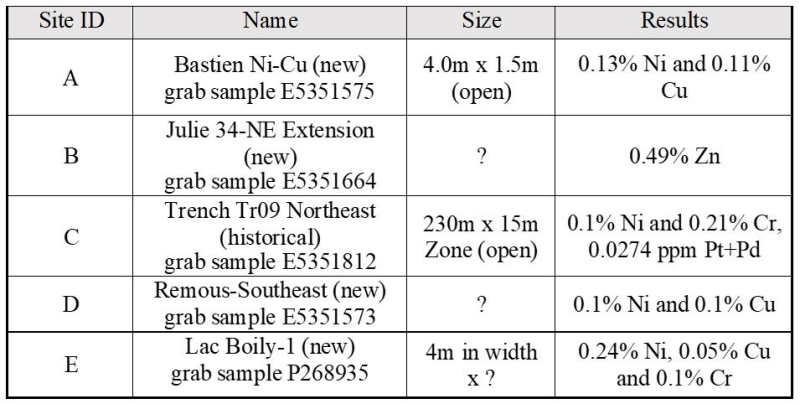
Click Image To View Full Size
Table 1. Significant results from summer 2021 fieldwork (Phase 1)
Phase 2 2021 fieldwork program (July-
Phase 2 of the field program was mainly conducted in the vicinity of the historical trench of
A bulk sampling of 170kg of mineralization hosted in trench T-1 (same as Figure 5) was collected. This bulk sample will be used to conduct metallurgical tests by St-Georges personnel. Elsewhere on the project, historical showings were revisited as well as new targets. Geological mapping and sampling was completed on these areas. Overall, a total of 107 grab samples, 84 meters of channel cut samples and some portable drill core samples were taken during Phase 2 of the fieldwork effort. The significant results of Phase 2that were received at the time of this press release are shown in Table 2.
The Company expects to receive most of the results of its 2021 drilling campaign on the
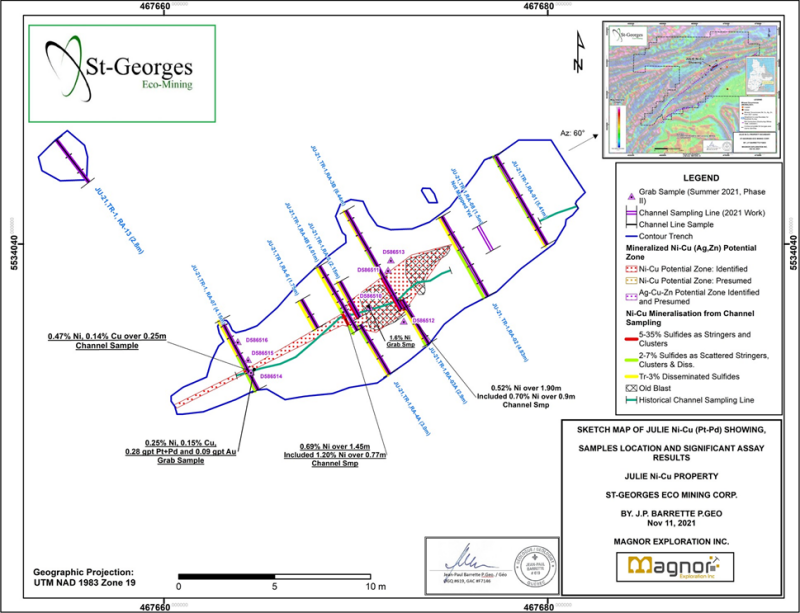
Click Image To View Full Size
Fig. 4:
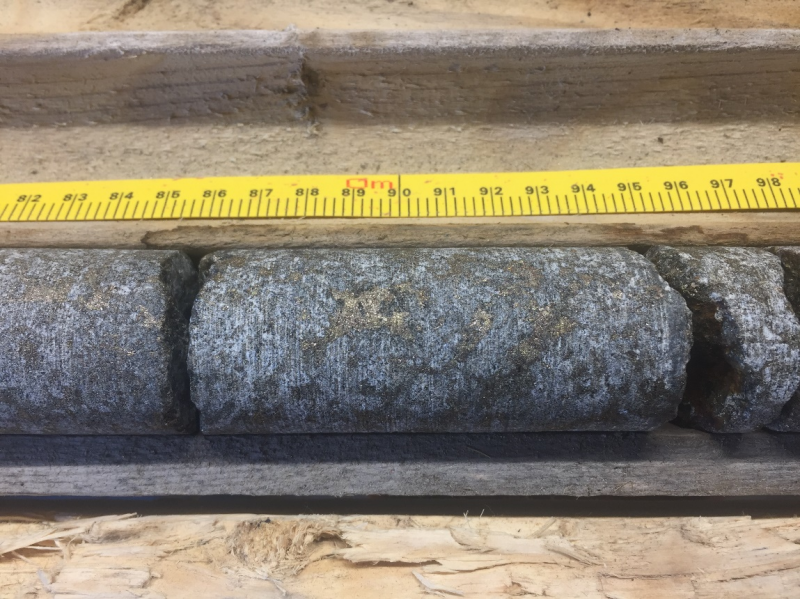
Click Image To View Full Size
Fig. 5:
Table 2. Significant mineralization results from Phase 2 of 2021 field exploration
Noticeable Results | Comment | |
|
(historical) |
| channel samples crosscutting at right angle the main mineralized zone (18m x 2.25m, open to SW and at depth) characterized by of semi-massive sulfides hosted in leuco gabbronorite and pyroxenite |
|
|
| channel samples crosscutting at right angle the main mineralized zone (4m x 1.5m, open NE and SW extension and at depth) characterized by massive sulfides pods, clusters, and stringers (< 4cm wide) hosted in fractured leuco gabbronorite and pyroxenite |
|
(historical) |
| channel samples crosscutting at right angle the main mineralized zone (45m x 5m, open all directions) characterized by mineralized graphitic paragneiss, gabbronorite sills and feldspar porphyritic felsic dike (Exploration is not completed) |
|
Remous (historical) |
Waiting for the assay results | Disseminated sulfides (Tr-3% PO+CP) clusters (<10mm wide) hosted in gabbroic anorthosite and troctolite (30m x 20m, open all directions) |
.
Borehole geophysics target generation on the
A TDEM (Time Domain Pulse EM) geophysics survey was undertaken in
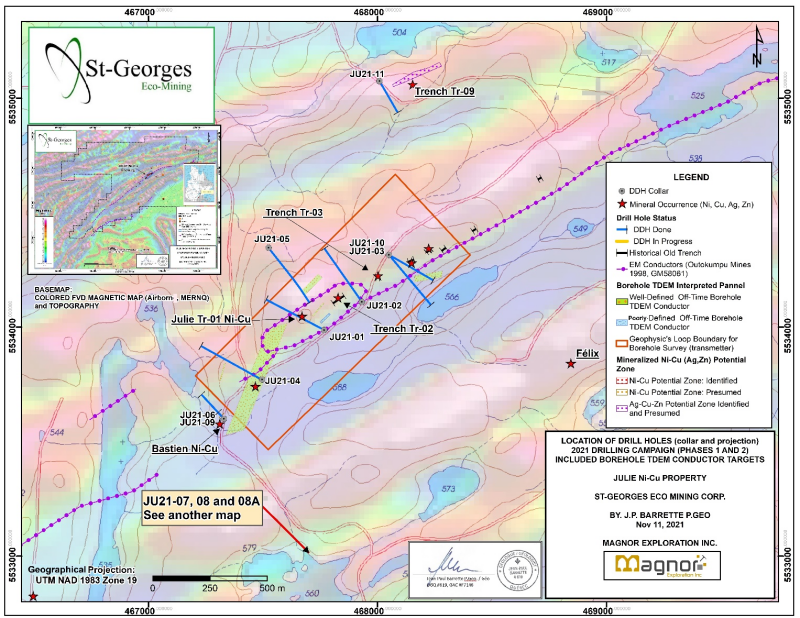
Click Image To View Full Size
Fig.6:
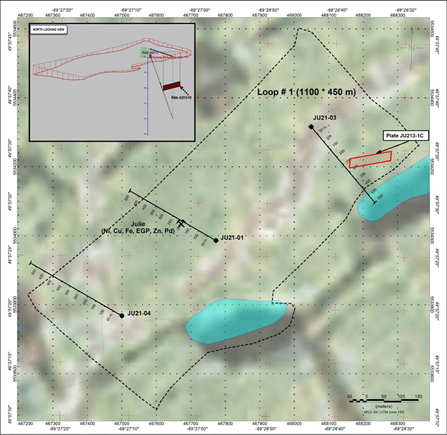
Click Image To View Full Size
Fig. 7: Julie Project: surface and at depth projection of TDEM conductor panel JU213-1C intercepted by drill hole JU21-10
2021 drilling campaign
Eleven (11) drill holes were completed totaling 4,198 meters of NQ size core. The drilling tested areas of
Phase 1 of the drilling campaign (5 drill holes JU21-01 to 05 totalized 2,256 m) were primarily drilled for stratigraphy and geophysical borehole surveys. The drill holes are concordant and discordant to the stratigraphy. The drilling campaign was also planned to test for the presence of discordant Ni-Cu mineralization such as feeder pipes or dikes of Ni-Cu-PGE mineralization underlying the Julie Ni-Cu (Zn, Ag) mineralized zone, including Julie T11.
Phase 2 (6 holes totalized 1,642m) was undertaken to test for continuityat depth and along strikeof Ni-Cu and Zn-Ag mineralization at the Bastien, Remous and T9 showings. Only hole JU21-10 targeted one of the high-priority TDEM conductors, JU213-1C. The other borehole TDEM anomalies will be tested in further drilling campaigns.
2021 Drilling Campaign (phases 1 and 2), Julie Project (updated Dec 2021) | ||||||||
|
Hole ID | Coordinates |
Elev. (m) |
Az |
Dip | Proposed Length (m) | Drilled Length (m) |
Comment | |
UTM_X* | UTM_Y | |||||||
JU21-01 | 467 773 | 5533986 | 588 | 300° | -55° | 500 | 504 | DDH for geophysics in hole Drilled under Julie Tr01 |
JU21-02 | 467 936 | 5534107 | 589 | 325° | -55° | 500 | 501 | DDH for geophysics in hole |
JU21-03 |
468 049 |
5534316 | 591 | 140° | -55° | 500 | 501 | Stratigraphic and exploration hole |
JU21-04 | 467 500 | 5533768 | 563 | 300° | -55° | 500 | 534 | DDH for geophysics in hole |
|
JU21-05 |
467522 |
5534346 |
562 |
140° |
-55° |
600 |
516 | Stratigraphic and exploration hole Abandoned at 516m |
JU21-06 | 467329 | 5533601 | 557 | 317 | -50 | 200 | 225 | Bastien Ni-Cu Showing |
JU21-07 | 469870 | 5530663 | 455 | 160 | -50 | 300 | 369 | Remous Ni-Cu Showing |
|
JU21-08 |
469870 |
5530663 |
455 |
160 |
-65 | 0 |
99 | Remous Ni-Cu Showing, Abandoned hole because wrong dip |
JU21-08A | 469870 | 5530663 | 455 | 160 | -72 | 200 | 201 | Remous Ni-Cu Showing |
JU21-09 | 467329 | 5533601 | 557 | 317 | -75 | 150 | 148 | Same set-up of JU21-06 but dip at -75° |
|
JU21-10 |
468 049 |
5534316 |
591 |
120 |
-50 |
350 |
351 | Same set-up of hole JU21-03 targeted on borehole geophysics target JU213-1C (high-priority, 303m) |
JU21-11 | 468 008 | 5535075 | 531 | 150 | -50 | 250 | 249 | Old trench TR-09 |
* UTM NAD83, Zone 19 |
4,050 |
4,198m | ||||||
Table 3. List of drill holes (NQ) from the 2021 Drilling campaign
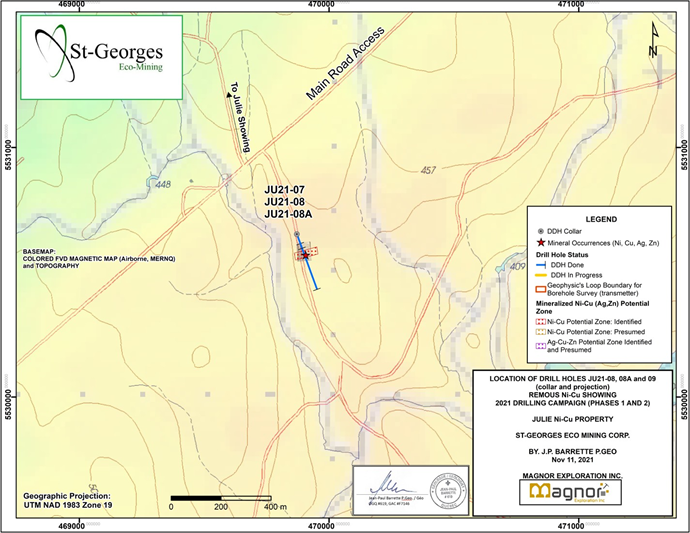
Click Image To View Full Size
Fig 8.
Niobium Showing Discovery
Lab analysis results for chosen surface samples collected by the Company’s contracted prospecting team from claims located near the municipality of
The first sample contained a massive vein of metal, potentially columbium, surrounded by iron oxide-rich carbonatite shell. The second sample showed no metallic veins but contained significant hematite and iron oxides (see picture 2 below).
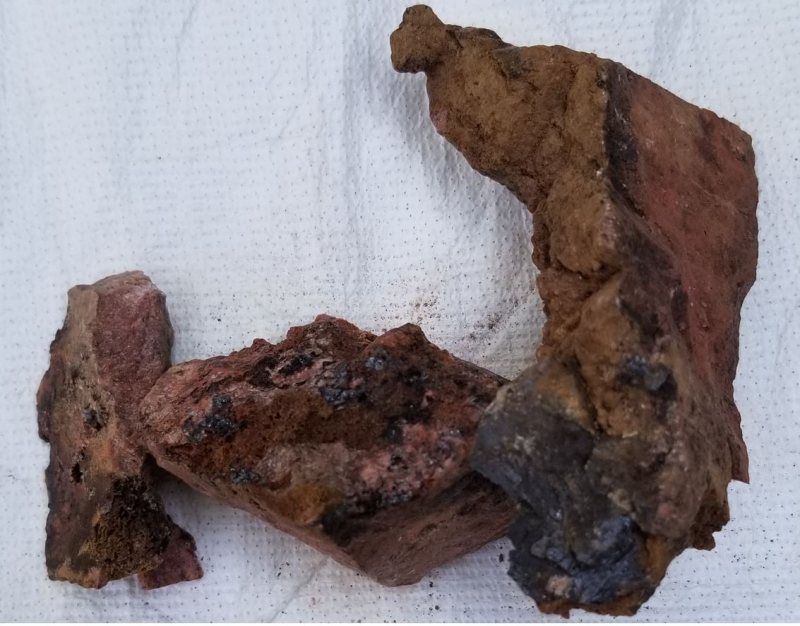
Click Image To View Full Size
Picture 2.
The first sample assayed greater than 0.5% niobium (upper limit of assay technique employed). This sample was collected from the margins of the metallic vein and consisted of mostly wall rock with some obvious disseminated to massive vein material.
The second sample had no metallic minerals present and appeared to be leached of metal. The sample contained low values of niobium (169 ppm) but assayed significant REEs with cesium (2040 ppm), lanthanum (870 ppm), neodymium (1050 ppm), praseodymium (255) and lesser but significant amounts of samarium and yttrium.
The Company believes the values from these samples indicate significant mineral potential depending on the extent of the mineralized area. Work shall be conducted on these claims in the new year to gain a better understanding of their potential.
STATEMENT BY JEAN-PAUL BARRETTE GÉO /
The information contained in this press release which relates to exploration results from the
The technical information contained in this report in regard to theNiobium Showing discoverynear
ON BEHALF OF THE BOARD OF DIRECTORS
“Frank Dumas”
FRANK DUMAS
COO & Director.
About St-Georges Eco-Mining Corp.
St-Georges develops new technologies to solve some of the most common environmental problems in the mining sector, including maximizing metal recovery and full circle EV battery recycling. The Company explores for nickel & PGEs on the Julie
The Canadian Securities Exchange (CSE) has not reviewed and does not accept responsibility for the adequacy or the accuracy of the contents of this release.
1 The question currently: Is the Ni-Cu mineralization of Julie T1 concordant or discordant with the orientation of the metasediments, and with the mafic-ultramafic intrusion complex on the surface and at depth?
Copyright (c) 2021 TheNewswire - All rights reserved.
Copyright (c) 2021 TheNewswire - All rights reserved., source

